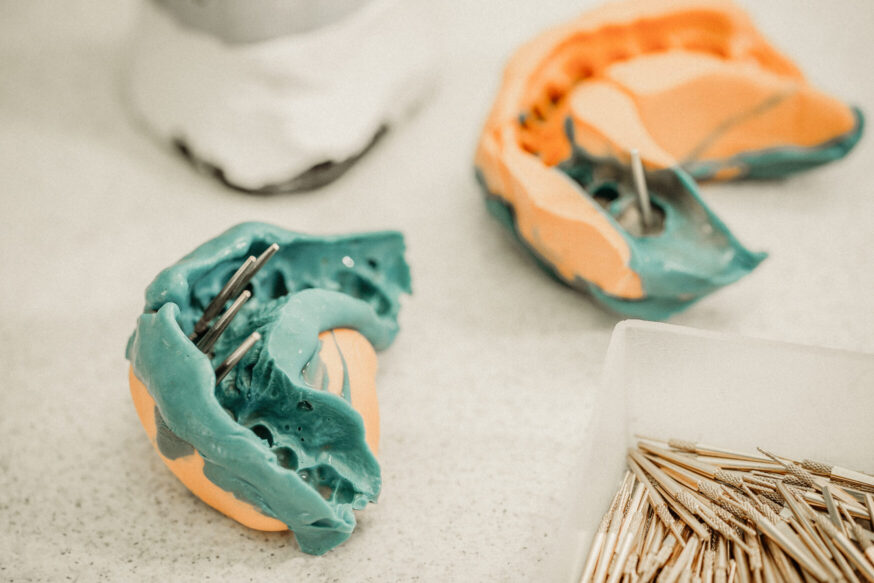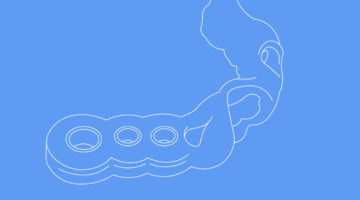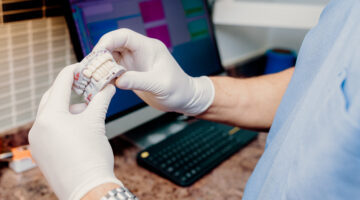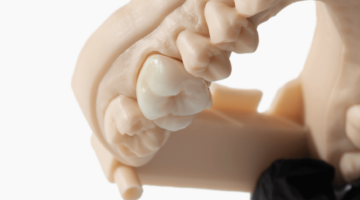Collecting accurate implant impression data is imperative to a successful implant case. There are a few ways to get it: Open tray vs closed tray impression was the argument forever but now digital dentistry provides a new answer/solution.
What is an open tray impression?
An open tray impression is a technique that employs impression copings attached to implants with a retaining screw extending past the tray and embedded in the impression. Before removing the impression, the clinician unscrews the coping through an opening in the tray.
Open tray impression technique
To take an open tray impression:
- Coat the impression tray with adhesives to retain impression material.
- Load the tray with heavy-body impression material and place light-body impression material around the copings to capture the soft tissue.
- Place the custom tray in the patient’s mouth, and expose the coping for easy access later by wiping away the material from the occlusal opening.
- After polymerization, loosen the screws in the temporary copings and remove the impression.
What is a closed tray impression?
In the closed tray impression technique, the clinician captures the post within the impression and after curing and impression removal, unscrews the post from the implant and reinserts it in the impression.
Closed tray impression technique
To take a closed tray impression:
- Affix closed tray impression copings on the implants (or multi-unit abutments)
- Load the tray with impression material and seat in the patients’ mouth
- Dislodge and remove the closed tray impression copings after polymerization
- Attach the implant or abutment analogs to the copings
- Insert the coping-analog assembly into the definitive impression
Open vs. closed tray impression
Research suggests that open tray implant impressions are more accurate for capturing multiple implants with different angulations. However, they are time-consuming and stressful for all involved.
By contrast, the closed-tray impression technique captures the implant and natural teeth in a single impression. It is ideal for single or multiple parallel implant impressions or when there is limited mouth opening or a sensitive gag reflex. However, transfers are less secure in the impression material, perhaps causing positions to vary when casting the model. Also, it can tear when you remove it from the patient’s mouth.
How digital dentistry changes an implant impression
However, a third option exists: digital implant impressions. Studies and experience show that using an intraoral scanner for a dental implant scan captures high-quality implant impressions.
Scan bodies enhanced the digital scanning data capture. After securing the scan body into the implant, like with an impression coping in a conventional impression, it captures important 3D data that labs use to produce the crown and stock or custom abutment.
Also, patients prefer digital impressions and clinicians like the accuracy scanners produce without the degradation that occurs with each step of a conventional impression technique. Both like that it takes less time without uncomfortable (and expensive) impression materials involved.
Open or closed tray, or digital can all produce high-quality implant impressions. However, patients and clinicians both prefer the comfort, cost, and time savings of digital implant impressions.
With accuracy so essential to case success, can you afford not to take digital implant impressions? Contact Dandy today to explore our digital solutions.
Sources
Impressions – Overview. Available at: https://www.for.org/en/treat/treatment-guidelines/edentulous-treatments/treatment-procedures/fixed-prosthetics/impressions/impressions-overview?active_tid=403 (Accessed: 6 July 2023).
Open or Closed? by Dr. Gary Radz (2023). Available at: https://www.dentaltown.com/magazine/article/7057/open-or-closed (Accessed: 6 July 2023).
Impressions of implants: pick-up and closed tray impressions (2023). Available at: https://magazine.zhermack.com/en/studio-en/pick-up-and-closed-tray-impressions/ (Accessed: 8 July 2023).
Imen, D., et al. Open Tray Impression Technique Using The Direct Pick-Up Coping: A Case Report (2023) Juniperpublishers.com. Available at: https://juniperpublishers.com/adoh/pdf/ADOH.MS.ID.555771.pdf (Accessed: 8 July 2023).
Deogade SC, Dube G. A sectional-splinting technique for impressing multiple implant units by eliminating the use of an open tray. Contemp Clin Dent. 2014;5(2):221-226. doi:10.4103/0976-237X.132347
Closed Tray Impression. Available at: https://www.icoi.org/glossary/closed-tray-impression/# (Accessed: 6 July 2023).
Marques S, Ribeiro P, Falcão C, et al. Digital Impressions in Implant Dentistry: A Literature Review. Int J Environ Res Public Health. 2021;18(3):1020. Published 2021 Jan 24. doi:10.3390/ijerph18031020
Wilk, DMD, B. (2015) Intraoral Digital Impressioning for Dental Implant Restorations Versus Traditional Implant Impression Techniques, Aegisdentalnetwork.com. Available at: https://www.aegisdentalnetwork.com/cced/2015/07/intraoral-digital-impressioning-for-dental-implant-restorations-versus-traditional-implant-impression-techniques (Accessed: 8 July 2023).



